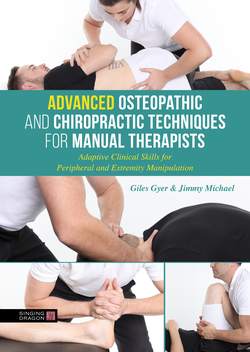Читать книгу Advanced Osteopathic and Chiropractic Techniques for Manual Therapists - Giles Gyer - Страница 25
На сайте Литреса книга снята с продажи.
No neurological connection between the spine and organs: A brief rebuttal
ОглавлениеIt is undeniable what the critics of spinal manipulation argue concerning its neurophysiological limitations in addressing visceral disorders. But we strongly disagree with the argument that manipulation has no reasonable theoretical basis to modulate visceral function. Although the corpus of literature is small, there is some evidence that spinal manipulation is beneficial for certain visceral disorders (Bakris et al. 2007; Budgell 1999). We agree that a comprehensive neurobiological rationale is still missing to justify our claim. However, this is not due to there being no neurological connection between the visceral system and the spine, but because of the limited interests of case studies and controlled trials in exploring neural mechanisms (Bolton and Budgell 2012). So far, only a few basic physiological studies in humans have been done to determine the mechanisms underlying the visceral responses of spinal manipulation. Some authors have already attributed these responses to somato-autonomic reflexes (Jowsey and Perry 2010; Moulson and Watson 2006; Perry et al. 2011). While this is not unreasonable, others have suggested alternative mechanisms such as an involvement of somato-humoral pathways (Bolton and Budgell 2012).
The autonomic nervous system (ANS) controls the involuntary bodily responses. It regulates and supplies various organs of the viscera such as the heart, kidneys, liver, lungs and digestive glands. The ANS also has potential interaction with the nociceptive (pain) system on multiple levels, which include the brain stem, fore brain, periphery and dorsal horn (Benarroch 2006). Therefore, any intervention that influences the functions of the ANS has significant clinical relevance. The effects of spinal manipulation on the ANS are well established in the literature. This has been demonstrated using various outcome measures such as heart rate variability, pupillary reflex and skin blood flow indexes (Bolton and Budgell 2012; Sampath et al. 2015). In addition, several studies done to investigate the neuroendocrine responses have reported a manipulation-induced increase in serum cortisol levels (Padayachy et al. 2010; Plaza-Manzano et al. 2014). Hence, in the theorised mechanisms of spinal manipulation, the peripheral sympathetic nervous system (PSNS) has been given a prominent role in the modulation of pain and inflammation.
Furthermore, after reviewing a range of mechanistic studies, Sampath et al. (2015) hypothesised that spinal manipulation might co-activate both the ANS and endocrine system. Since these two systems have been reported to work together, the authors suggested that post-manipulation changes in the ANS might be accompanied by changes in the function of the hypothalamic–pituitary–adrenal (HPA) axis. They also proposed a possible neural framework in support of their hypothesis. Taken together, it can be said that the autonomically mediated responses and the somato-humoural pathways are justifiable areas of research to demonstrate the visceral effects of spinal manipulation. In addition, it is totally baseless to say that mechanical stimulation of the spine has no neurobiological basis to influence the visceral organs. Even if there is no direct neural connection between the body’s organs and the spine, spinal manipulation could indirectly result in measurable changes in the visceral system mediated by the ANS.
